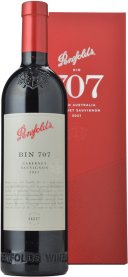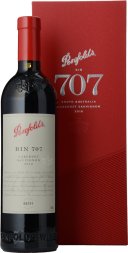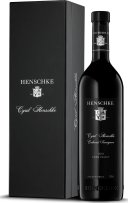$100 and over
Penfolds Bin 707
Bin 707 is a Cabernet Sauvignon reflection of Grange, intensely-flavoured fruit, completion of fermentation and maturation in new oak, expressing a Penfolds understanding of multi-vineyard, multi-region fruit sourcing. Bin 707 was first vintaged in 1964. The wine was not made from 1970 to 1975 when fruit was directed to other wines, nor in 1981, 1995, 2000, 2003 or 2011 (when fruit of the required style and quality was not available). Full bodied and with proven cellaring potential, Bin 707 retains a secure place among the ranks of Australias finest Cabernets.
Moss Wood Cabernet Sauvignon
One of Australia's icon wines, this is Cabernet at its very best. This wine is the very definition of power and elegance. Hand crafted by Keith Mugford and his team in the Margaret River, Moss Wood deservedly fits in the Exceptional category of Langton's Classification of Australian Wine.
Opus One
The 2014 Opus One exudes subtle aromas of fragrant florals, fresh garden herbs and forest floor that give way to a concentrated blend of red cherry, blackberry and black currant. Fine-grained tannins offer a velvety texture and complex structure that builds to a long, vibrantly fresh finish with a touch of mocha. Enjoyable now, the wine will delight for years to come. Oakville, California: Home to some of the most sought-after Cabernet Sauvignon in America, Napa Valley's Oakville district stretches across the center of Napa's valley floor and foothills between the Vaca and Mayacamas Mountains. This AVA is home to the legendary To Kalon Vineyard and Martha's Vineyard, as well as many powerhouse wineries including Screaming Eagle, Silver Oak, Robert Mondavi, Opus One, Far Niente and Groth. The climate is generally warm and agreeable, resulting in year after year of favorable vintages. Summer days see a gentle tug of war between warmer inland air and the cool air coming in from the San Pablo Bay, creating an ideal environment to grow red varieties. Oakville's diverse soils, namely ancient sea bedrock, clay and gravel, are well-drained, and perfect for high-caliber viticulture. Cabernet here is often bottled varietally but is also popular in Bordeaux Blends. Oakville wines are known for their silky, sensual textures, structured tannins, dark and brooding fruit and lovely aromatics. These age-worthy and prestigious wines are favored by collectors throughout the world.
Penfolds Bin 707 Cabernet Sauvignon (Gift Boxed)
Product Information: A blend of four regions – Coonawarra, Barossa Valley, Padthaway and McLaren Vale – from a cool vintage. The Penfolds Bin 707 Cabernet Sauvignon 2022 is a remarkable wine that has been matured for 16 months in American oak hogsheads that are 100% new. This wine has been crafted using exceptional grapes grown in Coonawarra, Wrattonbully, and Barossa Valley regions. The 2022 season was generally cool, with the prevailing conditions delaying harvest by several weeks. The extra hang hang-time allowed the grapes to develop lovely varietal characters and balanced ripe tannins. Bin 707 is a perfect cabernet sauvignon representation of Penfolds ‘House Style’: intensely-flavoured fruit; completion of fermentation and maturation in new oak; expressing a Penfolds understanding of multi-vineyard, multi-region fruit sourcing. Inspired by the iconic jet that took it to the world. The rich and powerful Bin 707 Cabernet Sauvignon, our first commercial release of a single cabernet-based wine, is linked to Max Schubert’s dream of making a great Australian red wine that could last at least 20 years. During the ‘50s and early ‘60s cabernet sauvignon was mostly used for blending, but Schubert’s breakthrough with the varietal as a stand-alone wine came in 1964 with inaugural vintage. Early Bin 707s were typically open fermented under wax-lined header boards and matured in seasoned old oak (rather than new oak). The wine was not made from 1970 to 1975 (when fruit was directed to other wines) nor in 1981, 1995, 2000, 2003, 2011 or 2017 (when fruit of the required style and quality was not available). Full-bodied and with proven cellaring potential, Bin 707 retains a secure place among the ranks of Australia’s finest cabernets. Maker: Penfolds has been a pioneer in the world of winemaking since its establishment in 1844 by Dr. Christopher and Mary Penfold. The company's success has been driven by a lineage of visionary winemakers who have pushed the development of the company to extraordinary, bold new heights. Mary Penfold's reign at the helm of Penfolds saw years of determination and endeavour, experimenting with new methods in wine production. In 1948, Max Schubert became the company's first Chief Winemaker and he propelled Penfolds onto the global stage with his experimentation of long-lasting wines - the creation of Penfolds Grange in the 1950s. Soon, the medals began flowing, and Grange quickly became one of the most revered wines around the world. In 2012, Penfolds released its most innovative project to date - 12 handcrafted ampoules of the rare 2004 Kalimna Block Cabernet Sauvignon. Today, Penfolds continues to hold dear the philosophies and legends that have driven the company's success since its establishment in 1844. Vineyard: In Coonawarra, spring's cooler temperatures led to nine days of sub-2°C weather. The deployment of frost fans proved effective in safeguarding vine shoots against these cold snaps. Warm weather prevailed in December, setting the stage for superb flowering and fruit-set conditions. Veraison was uniform across vineyards, leading to consistent grape development allowing flavour, tannin, and colour to flourish during the final ripening phase under near-perfect conditions. The Barossa Valley experienced cooler-than-average temperatures coupled with spring thunderstorms. Despite this, yields and grape quality surpassed expectations even among vines impacted by hail. A particularly arid yet cool December slowed down fruit-set, however, robust canopies played a pivotal role in driving up sugar levels and physiological maturity without the risk of dehydration at harvest time. The cooler growing season also fostered excellent acid retention which translated into grapes that were both finely structured and balanced. Padthaway encountered a frost event in October, but enjoyed an otherwise gentle growing season, free from extreme heat spikes or rain delays at harvest time. McLaren Vale reported only three days exceeding 35°C - half what was recorded for the previous year's vintage - resulting in a gradual harvest that allowed Cabernet Sauvignon grapes to be picked at their peak condition. Nose - Peppermint, Blackcurrant, Woodsmoke Peppermint, vanilla, blackcurrant, bay leaves and woodsmoke, peppercorns wrapped in milk chocolate. Palate - Cherry Chocolate, Sage, Savoury Olives Blackberry compote, cherry chocolate, nutmeg, bay leaf, sage herbals, iodine and Mediterranean black olive savoury notes. Finish - Thyme, Intense, Lingering Woodsy Spice This is a muscular red wine with the smoothness of oil. It looks good for drinking even now, as intense as it is, but it will outlive most of us.
Yarra Yering Agincourt Cabernet Malbec
Penfolds Max's Cabernet Sauvignon (6 )
Penfolds Max’s Cabernet Sauvignon is a tribute to former Chief Winemaker, Max Schubert 1948- 1975, a legend in Penfolds history. Max’s constant pursuit of excellence paved the way for those who followed in his footsteps and also allowed the status and heritage of Penfolds to grow. Max’s Cabernet Sauvignon displays the Penfolds ‘stamp’ inspired by Max Schubert.
Penfolds Bin 169 Cabernet Sauvignon
Bright plum in colour, Penfolds Bin 169 Cabernet Sauvignon displays delicate notes of mint and blackcurrant, with a more savory bouquet of semi-dried tomatoes and fruit chutney at the end. A hint of oak and spice adds extra warmth. On the palate a flavour-wheel of spearmint, milo powder, chocolate and black liquorice.
Henschke Cyril Henschke Cabernet Sauvignon
Henschke's flagship Cabernet is named after the late Cyril Henschke who purchased the Eden Valley property in the 1960s. Stephen and Prue Henschke then established the vineyard with Cabernet Sauvignon, Merlot and Cabernet Franc vines which produces this intensely perfumed Cabernet. Matured in 100% new French oak for 18 months, this exceptional wine shows blackcurrant and cedar characters balanced with superb fine grained tannin.
Cullen Wines Diana Madeline
Certified biodynamic and organic. Magnificent pitch black colour with a very deep bright dark red black hue. On the nose a lovely mix of red to black currant and mulberry scents morph into violet, vanillin cedar, dried herb, tobacco, black olive and spicy bay leaf notes. Medium bodied, elegant and superbly structured, the palate features a tightly knit matrix of red to black currant, mulberry and black olive flavours. Bright youthful acidity and an assertive grainy tannin structure provide an iron girder like core. Notions of tobacco, dried herbs, vanillin cedar and spicy bay leaf infusions also chime in. Restrained and understated in its power at present it concludes long and rich yet compact. Cellar 10-20 years. Alc. 13%
Chateau Latour Pauillac Premier Grand Cru Classé
Château Latour is situated in the heart of the Médoc wine region, about 50 km north-west of Bordeaux, where the legend of the vineyards of Bordeaux began. The Château’s prime terroir, l’Enclos, overlooks the Gironde Estuary which, over the centuries, has given the vineyard its geological complexity and, on a daily basis, ensures a mild climate. In the years since 1993, under the leadership of the Pinault family, the estate’s owner, significant changes have been made with a view to maintaining Château Latour’s pursuit of excellence in the wines that it produces. Dark ruby in colour with a very elegant nose with beautiful aromatic purity. Generous and powerful on the palate with a velvety mouthfeel, full of silky tannins. Brimming with energy, the finale is superbly precise with fabulous length.
















































































